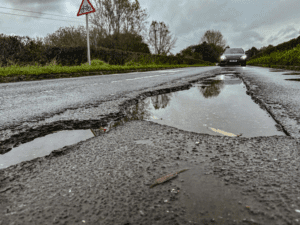Horizon scanning – why it belongs in every risk manager’s toolkit

‘What to tackle first?’ To many, it’s the question that’s shaping the insurance landscape in 2023 after reports from organisations, including the World Economic Forum, BIBA, Aviva, Gallagher Re and Howden, underscored the interplay of external risks impacting businesses and creating financial and operational challenges.
But for risk managers such as Airmic board member, Richard Hoult (pictured), whose role it is to keep an eye on the risk horizon, it’s essential that businesses also don’t lose sight of the all-important questions of ‘what if?’ and ‘what next?’ Outlining the increasing importance of horizon scanning in businesses of every size and sector, Hoult, who serves as head of risk and internal audit at Portakabin, first outlined the four characteristics that define horizon scanning.
“Horizon scanning is the proactive, forward-looking activity of identifying new risks to an organisation,” he said. “The four characteristics that identify these risks are that they are plausible, relevant, new to the organization in question and beyond the normal time horizon of risks identified by that organization.”
For Hoult, building advanced understanding, interest and acceptance of horizon scanning as a critical instrument in the toolkit of organizations has been a long-standing commitment. And having spent over a decade in risk management roles at companies including British Gas and Thames Water, he has seen first-hand how these conversations are slowly but surely beginning to evolve.
“I joined Portakabin about five months ago,” he said. “My role is to lead our risk and internal audit function which was previously outsourced, and bring it in-house so it can help support the business’s growth strategy as we’ve got some exciting growth targets as a business. To be asked to come and help support that is great and really refreshing as risk managers don’t often get pro-actively invited to the table to get involved with the strategy and forward-planning piece.”
That shift from risk management as an afterthought to embedding risk management into the DNA of a business’s strategic growth objectives has been interesting to see, Hoult said. So, he’s keen not just to continue the conversation across the risk management sector but also to evolve its boundaries – with horizon scanning a critical consideration.
Horizon scanning allows businesses not just to see into the future but also to register the impact those horizon risks will have when they become too pressing to be ignored any longer. Highlighting the potential value of the tool, Hoult highlighted supply chain concerns (at Thames Water) around the availability of chemicals required to treat water and shifts in the telephony environment with the move from analogue lines to digital, and how horizon planning could have been used proactively to put structured strategies in place.
He noted that understanding challenges beyond the immediate – some of which don’t need to be tackled straight away but do need to be assessed and recognised – is what allows firms to invest in the infrastructure necessary to forestall the risk. That forward-planning is what allows business leaders to do the budgeting, resource planning and labour allocations ahead of time to ensure that they are better prepared for long-tail risks.
The mistake of not looking to the future is not unique, Hoult said. “Some firms have the same view of leaving it to later, or leaving it too late, or not even recognising these risks as horizon risks. That’s one of the frustrating things around horizon scanning – as a risk manager you can flag the risks and put your hand up to make sure the executive team and the board are aware of them – but it’s down to their appetite whether or not they actually do anything with it.
“So, what I want to do is make sure they’re making informed decisions, making sure they’re being given insights into how they can prioritise investments now and into the future,” he said. “It’s about them being empowered to make conscious decisions rather than under pressure decisions. I also think it helps the boards of organizations get a level of comfort and assurance that the business is thinking about things that are outside of the normal planning horizons and really looking to the future.”
Understandably, most executive teams tend to be looking only a year or maybe two years ahead, Hoult said, while boards take a longer-term view of strategy. And so horizon scanning offers an opportunity for leadership teams to all be facing in the same direction. Having that visibility of the future is critical, and understanding what is coming down the lines allows for more open, collaborative discussions around budgeting and areas of strategic focus.
“This risk management instrument is still fairly immature for most businesses, and it’s not a concept that people use all the time,” he said. “So, I think it’s one of those things that where people find easier ways to present their findings and use them, horizon scanning will start to be used more and will start becoming a go-to tool that a risk manager can use.”
From discussions with other risk managers, Hoult noted there is demand for a comprehensive framework that will provide structure to the horizon scanning initiatives. With so many possible risks to think about, risk managers need a way to break these down by relevance and by timing, planning and resource commitments. It would be helpful to have that framework in place, built by risk managers and portfolio managers and aimed at supporting the wider profession in creating the right structures to quantify, model and ultimately manage horizon risks.
“As a board member at Airmic, I think this will help move the profession forward, and I’m keen to support the implementation of such a framework or model, because I haven’t found one yet that’s applicable and accessible to a range of businesses and industries,” he said. “The right model will move horizon scanning out of the realm of being a theoretical tool, it will include inputs around costs, the relevance of risks and how these risks might impact your strategy as a business.
“I see it as a set of questions that would help you come up with a score. And that score would tell you where you should be spending your investment budget now to prevent you from having to get to panic stations in the future.”
What are your thoughts on the benefits of horizon scanning? Please feel free to share your comments below.





